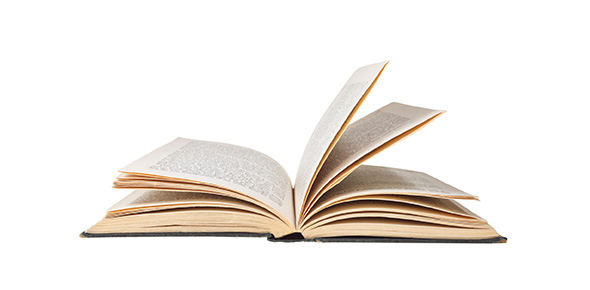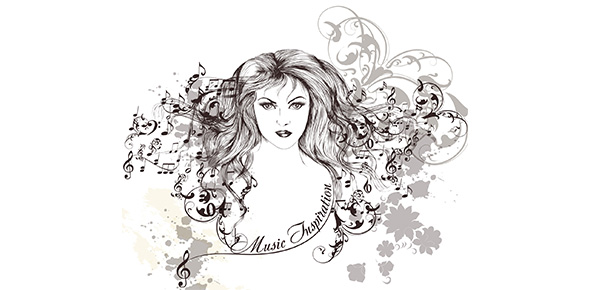Related Flashcards
Related Topics
Cards In This Set
| Front | Back |
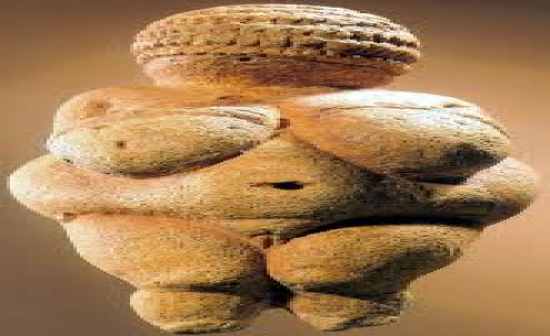 |
Nude Women, from willdendorf .
Material: limestone Name: Nude Woman (Venus of Willendorf) Culture: prehistoric-paleolithic Date: 30,000-8000 (paleolithic) The Human figure is depicted in an abstract style in which forms are simplified and not true to appearance. The anatomical exaggerations in this tiny figurine from Willendorf are typical of Paleolithic representations of women, whose child bearing capabilities ensured the survival of the species. |
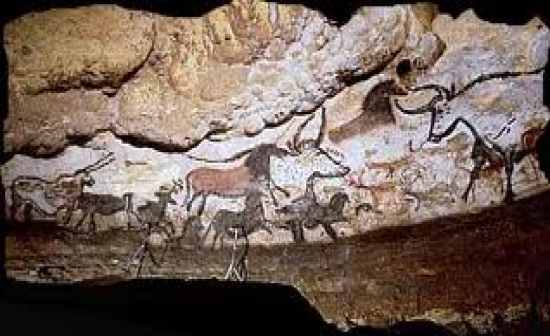 |
Name: Cave at lascux france
Culture: Prehistoric-Paleolithic Material: Painting Location, Lascaux, France Date: 30,000-8000 The murals exhibit the two basic approaches to drawing and painting found repeatedly in the history of art-silhouettes and outlines. The Lascaux bulls also show a convention of representing horns that art historians call twisted perspective or composite view. |
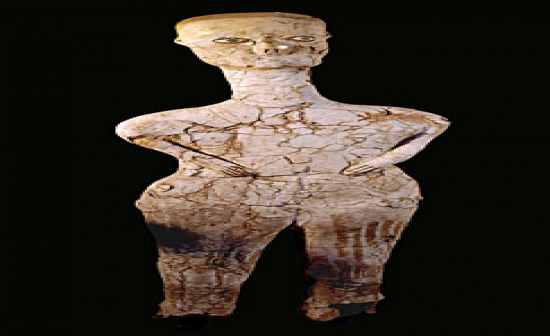 |
Name: Human figure
Location: Ain Ghazal, Jordan Date:ca. 8000-2300 Material: Plaster, painting and inlaid with bitumen. Culture: Prehistoric-neolithic They are much bigger than the paleolithic nude women sculpture and this piece marked the beginning of monumental sculpture in Mesopotamia. |
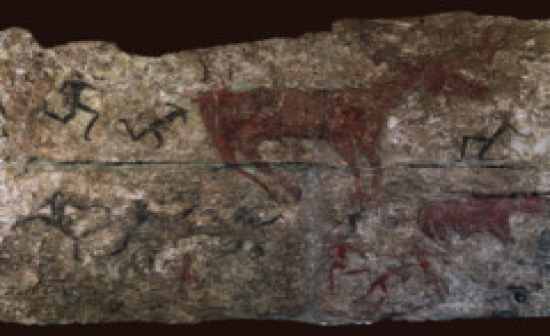 |
Name: Deer Hunt, ptg.
Location: from Çatal Höyük, Turkey Date: 8000-2300 Material: pigment on a background of dry white plaster culture: prehistoric-neolithic The body is depicted in a composite view with a frontal torso and profile head and legs. In contrast to paleolithic art, human themes and concerns and action scenes with humans dominating animals are central subjects of neolithic paintings. |
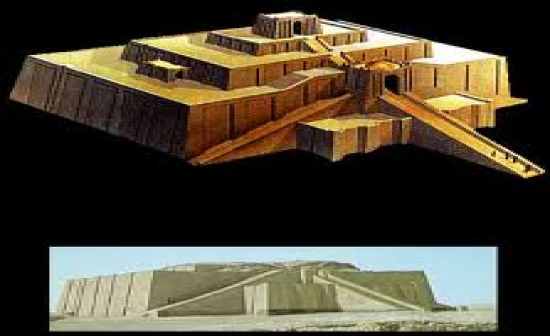 |
Name: White Temple and Ziggurat,
Location: Uruk, Iraq Date: ca. 3500-2332 BCE Material: mud bricks Culture: Ancient Near eastern-Sumerian Using only mud bricks, the Sumerias errected temple platforms called ziggurates several centures before the Egyptians bulit stone pyramids. The White Temple at Uruk was probably dedicated to Anu, the sky god. It had a central hall (cella) with a stepped altar. There, the Sumerian Priests would await the apparition of the deity. |
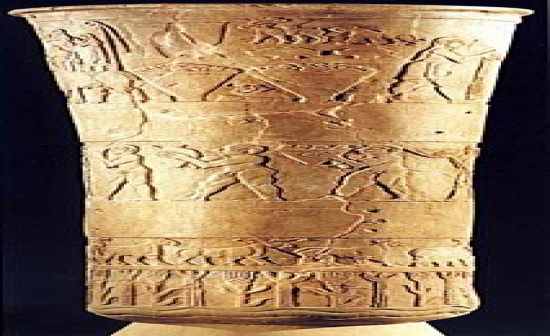 |
Name: Warka Vase
Location:Uruk, Iraq Date: ca. 3500-2332 BCE Culture: Ancient near eastern-Sumerian In this oldest known example of sumerian narrative art, the sculptor divided the tall stone vase's reliefs into registers, a significant break with the haphazard figure placement found in earlier art. Heirachy of scale was exhibited in this piece-the greater height of the priest-king and Inanna compared with the offering bearers indicates their greater importance. It also included conceptual representation-composite of frontal and profile views. |
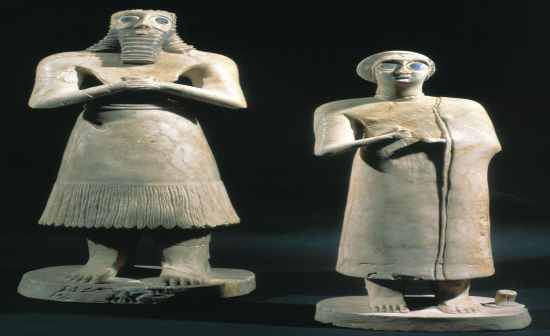 |
Statuettes from Square Temple at Eshnunna
Date: ca. 3500-2332 Culture: Sumerian (ancient near eastern art) Location: Eshunna, iraq The oversized eyes probably symbolize the perpetual wakefulness of these substitue worshipers offering prayers to the deity. The beakers the figures hold were used to pour libations for the gods. |
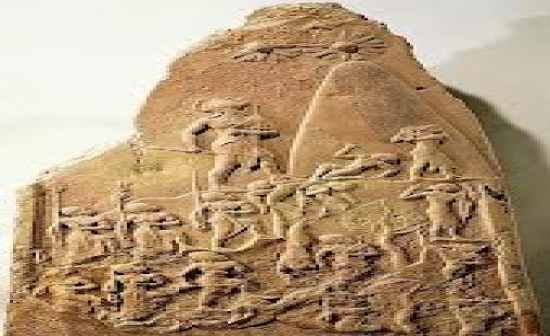 |
Victory Stele of Naram-Sin
Location: Susa, Iran Date: 2332-2150 Culture: Akkadian (ancient near eastern art) material: pink sandstone To commemorate his conquest of the Lullubi, Naram-sin set up this stele showing him leading his army up a mountain. The sculptor staggered the figures, abandoning the traditional register formate. |
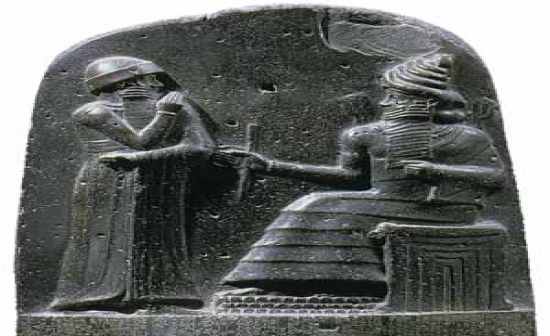 |
Stele with law code of Hammurabi
Culture: babylonian Date: 2150-1600 Location: Susa, Iran material: basalt *Crowning the stele recording Hammurabi's laws is a representation of the flame-shouldered sun god Shamesh extending to the Babylonian king the symbols of his authority to govern and judge. There are 3500 lines of cuneiform and 282 Laws. the rod and coil were given to him so he could "measure" out laws and seek justice. The rod and coil symbolized authority, holding law and order. |
 |
Lamassu, Citadel of Sargon II,
Location: Dur Sharrukin, Iraq Date: 900-539 Culture: Assyrian Material: Limestone *Guarding the gate to Sargon's palace were colossal limestone monsters, which the Assyrians probably called lamassu. These winged, man-headed bulls served to ward off the king's enemies. The ancient sculptors insisted on complete views of animals. This four-legged composite monster that guarded the palace has 5 legs-two when seen from the front and four in profile view. |
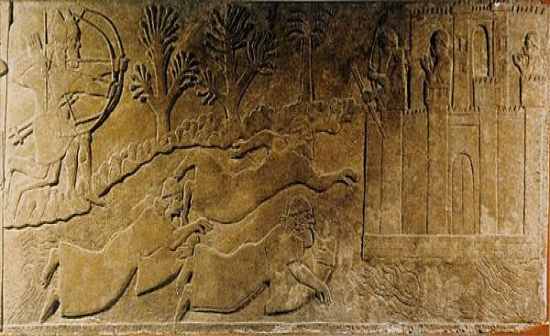 |
Relief from Palace of Ahurnasirpal II, Kalhu
Date: ca. 900-539 Culture: Assyrian Location: Kalhu, Iraq Material: gypsum *Extensive reliefs exalting the king and recounting his great deeds have been found in several Assyrian Palaces. This one depicts Ashurnasirpal II's archers driving the enemy into the Euphrates River. Ancient painters often compressed distances and enlarged the human actors so they would stand out from their environment. |
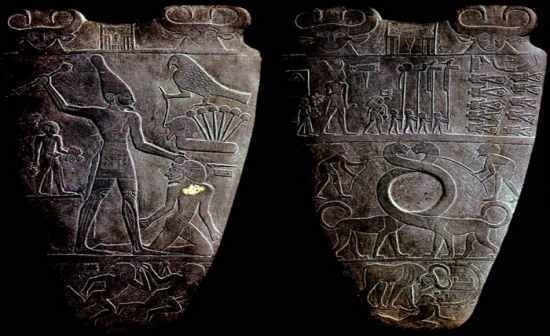 |
Palette of King Narmer
Date: ca. 3500-2920 Culture: Egyptian-predynastic Location: Hierakonpolis, Egypt Material: Slate *Narmer, king of Upper Egypt, wears the crown of Lower Egypt as he reviews the beheaded enemy bodies. Below, the intertwined animal necks may symbolize the unification of the two kingdoms. |
 |
Mortuary precinct of Djoser, Saqqara
Culture: Egyptian-early dynastic Date: 2920-2575 Location: Saqqara, Egypt Material: Limestone *Djoser's pyramid was the centerpiece of an immense funerary complex that included a mortuary temple, other buildings, and courtyards. A network of underground galleries resembled a palace. |
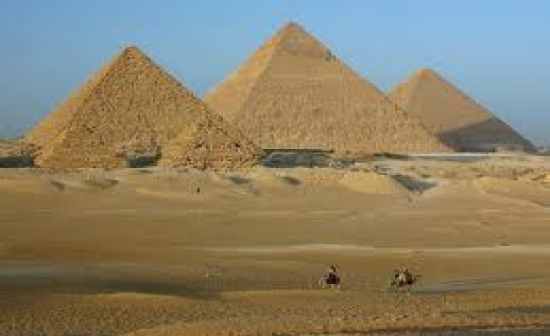 |
Pyramids at Gizeh, sphinx
Culture: Egyptian-Old Kingdom/Fourth Dynasty Date: ca. 2575-2134 Location: Gizeh, Egypt *The great pyramids of Gizeh took the shape of teh ben-ben, the emblem of the sun, Re. The sun's rays were the ramp the Egyptian pharaohs used to ascend to the heavens after the death and rebirth. They served as the tombs of the fourth dynasty pharaohs Kufu, Khafre and Menkaure. |
 |
.Seated statue of Khafre
Location: Gizeh, Egypt Date: 2575-2134 Culture: Egyptian-Fourth Dynasty Material: Diorite *This portrai from his pyramid complex depicts Khafre as an enthroned divine ruled with a perfect body. The rigidity of the pose creates an aura of eternal stillness, approriate for the timeless afterlife. **the subsitute home for the KA |



